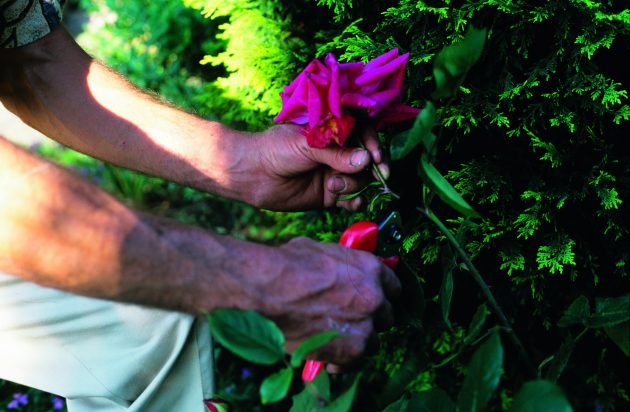For those cursed with clay soil, garden roses are ideal: colourful, richly fragrant, adaptable and almost endless in variety. They define the word 'summer' says Ursula Buchan
I can’t help it. Every time a friend tells me that they bought their house because of the wonderfully friable, medium loam soil in the garden, I gnash my teeth. How I should love such a house. But I chose to live in Northamptonshire, where there’s a good chance any house will have a garden on an unforgiving alkaline clay. This soil bakes hard in summer and is slippery, wet and easy to compact in winter. Sure, there are some village gardens that have been worked for centuries, so that they now give pleasure and profit to their owners. But plenty have not and mine is one of them. The sole part of my garden that can boast a light, really workable soil is the border next to the redundant outside ‘privy’. Presumably, it was the recipient of shovelfuls of ‘night soil’ on moonlit evenings until the 1950s.
However, as old gardeners used to say, ‘a clay soil will break your back but not your heart’. They meant that clay soils, though hard work, retain minerals so well that plants, once established, will thrive in them. And, over the years, I have learned to get round some of the drawbacks of a very heavy soil. Since I firmly believe that digging only disrupts the vital microbial relationships in the soil, as well as making my hands blister like old paintwork, I simply lay a thick organic mulch on my raised vegetable beds each autumn. Come spring, I then only fork over the top very lightly. Just enough to make a seedbed, in fact.
Thank goodness for roses
Initially, I filled the beds with home-made compost and decent imported topsoil, so the clay is now buried to a depth of a foot or more. The only downside to this autumn mulching is that badgers seem to delight in scrabbling below the surface, on the quest for earthworms. Cue more gnashing of teeth. Thank goodness for garden roses, which positively revel in a heavy clay soil if you treat them properly and plant them carefully. Indeed, in my garden they do worse in the Privy Border, losing vim and flower power over time.

Nothing says ‘summer’ more than a rose in full bloom
It’s true that species roses, such as the Scottish briars, Rosa spinosissima, and the Japanese Rosa rugosa, do well in a light, free-draining soil. However, highly bred roses, such as hybrid teas, floribundas and English roses, which are grafted on to socalled Rosa laxa rootstocks, do actively better on a heavy soil. The rootstock, laxa, is actually a form of the dog rose, Rosa canina. This has an immensely wide distribution in northern temperate regions, from Britain to Mongolia, so naturally is unfussy as to soil, only disliking really dry ones.
Endless variety of garden roses
Yes, thank goodness for roses. In June, when most start (and some end) their flowering, they define the word ‘summer’ for us. And there is no end to their variety. Since the year dot, gardeners have been hybridising them, so that many have bloodlines more complex than racehorses – although considerably less temperamental. That heterogeneity is the key to why roses can be found for most situations in the garden. There are climbers, ramblers and pillar roses, if it’s vertical accents that you are after, while shrub roses, bush roses and groundcover roses can be planted in borders. Some do best in semi-shade, whereas others are only really happy on a south-facing wall. It’s horses for courses, if you will forgive another equine metaphor.

Roses bring no end of pleasure but do require pruning
And the quality, durability and ease of cultivation of roses has improved greatly in the past 50 years. This is in good part to English rose breeders, notably David Austin, Peter Beales and the Harkness family. They have improved not only the disease resistance of many – so important since no one wants to spray fungicides – but also the range of colours, scents and flower shapes. And perhaps most importantly, their capacity to flower more than once in a season, or even continuously throughout the summer. It is true that some have a rather angular and ungainly growth habit, many have wicked thorns and most don’t much like really strong competition from plants round their roots. But as I wander out into a balmy June evening to smell the fruity fragrance of apricot yellow ‘Sweet Juliet’, a rose never out of flower till October, my teeth remain resolutely ungnashed.
Want to read more about gardens?
The Field is packed with content that keen gardeners will love. Read about one man’s search for the ideal lawn tractor here. While novice gardeners look no further than Ursula Buchan’s guide on where to find the best advice.





